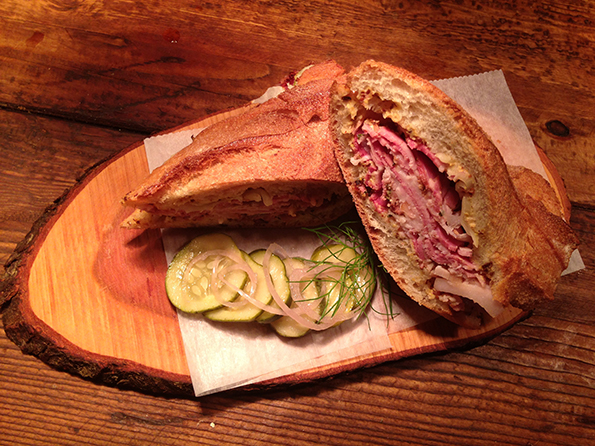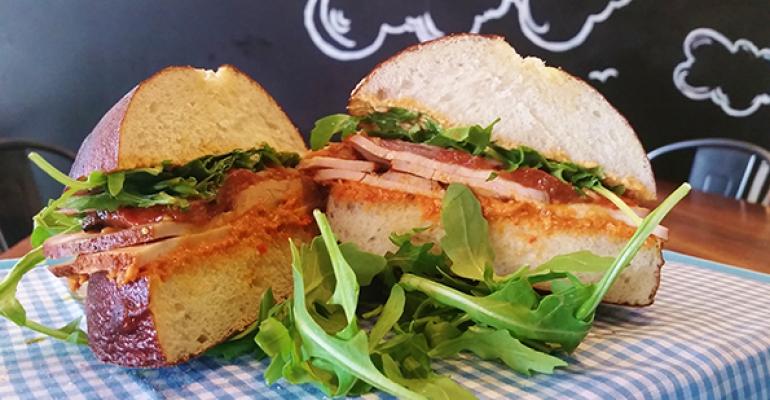No meal is more central to the American diet than the sandwich. Portable, convenient and eminently customizable, it fits the needs of the modern consumer, and recent research shows that there’s still a long runway for growth of sandwich sales in restaurants.
Americans ate 12.5 billion sandwiches in restaurants from October 2013 to October 2014, according to consumer researcher The NPD Group. But a recent survey of more than 1,000 consumers by menu research firm Datassential found that even more sandwiches are eaten at home, with ingredients bought from supermarkets and other retailers.
It’s not that restaurants aren’t offering sandwiches: More than seven out of 10 restaurants have sandwiches on their menu, including six out of 10 fine-dining restaurants, according to Datassential. But consumers eat different sandwiches at home than in restaurants, the menu research firm found. More than three-quarters of ham and turkey sandwiches are prepared at home and eaten cold, while 57 percent of chicken sandwiches are warm and bought away from home.
Datassential managing director Brian Darr said in a press release about the survey that sandwiches offer great opportunities for both foodservice and supermarkets.
“The popularity of sandwiches allows restaurants and retailers a broad platform on which to develop new appealing varieties along with tried-and-true favorites,” Darr said.

“Today’s consumers are encountering a wider variety of sandwich options and flavors,” including those with different regional and ethnic influences, as well as those with more healthful and premium ingredients and artisan flourishes, Darr added.
One operator capitalizing on ethnic and artisan preferences is Tavern Road Street Foods in Boston, with its porchetta sandwich.
Chef Louis DiBiccari rubs pork shoulder in a paste of lemon zest, parsley, thyme, rosemary, sage, oregano, coriander, fennel pollen, roasted garlic and olive oil, and lets it sit overnight. Then he roasts it over high heat in a pan containing carrots, celery, onion, cinnamon, lemon, fennel and garlic. Once the vegetables start to caramelize, he deglazes the pan with white wine and pork stock, lowers the heat and lets the steam from the pan continue to flavor the pork while it roasts for another hour or so. He lets the porchetta cool overnight and then slices it.
“It’s like the best deli meat ever,” DiBiccari said. He puts the sliced meat on a baguette with roasted broccoli raab and mustard, finishes it in a hot oven and sells it for $8.95.
Regional and ethnic variations abound elsewhere. These include the Haddock Reuben at Robert’s Maine Grill in Kittery, Me., which features breaded fish fillets served on toasted rye bread with ale-braised cabbage, Swiss cheese and spicy tartar sauce.
Russell House Tavern in Cambridge, Mass., does a mashup with its Lobster Bánh Mì. Chef Tom Borgia’s variation on the Vietnamese sandwich replaces the usual roast pork and pâté with New England’s favorite local crustacean, slathered with Sriracha aïoli and dressed with pickled carrots, radishes, jalapeños, mint, cilantro and Thai basil leaves, served on a baguette.
Although healthful items, or at least items perceived as healthful, are increasingly an important factor for consumers, sausage is the fastest-growing sandwich protein, according to Datassential MenuTrends, which tracks menu mentions of items at more than 4,000 chains and independent restaurants across the country. Datassential found that sausage sandwiches are on 10 percent more menus than they were a year ago.
New sausage sandwich additions at chains, apart from an array of breakfast sausage sandwiches, include the Mini Bratwurst at 35-unit Gordon Biersch Brewery Restaurant, based in Chattanooga, Tenn. The sandwiches, priced at $3.95 each, feature a miniature sausage simmered in lager, finished on the grill and served on a pretzel bun with caramelized onions and Märzen mustard.
Chicken still reigns
(Continued from page 1)
Still, chicken, which customers widely see as better for them than most other animal proteins, is the most ubiquitous. Chicken was available on sandwiches at 85 percent of restaurants that offered sandwiches as of June 2014, according to Datassential MenuTrends. Chicken is unquestionably the most popular protein at Pita Pit, a fast-casual chain based in Coeur d’Alene, Idaho, with 242 units in the United States and more than 500 worldwide.
Chicken is unquestionably the most popular protein at Pita Pit, a fast-casual chain based in Coeur d’Alene, Idaho, with 242 units in the United States and more than 500 worldwide.
Stephanie Powers, Pita Pit’s vice president of field operations, said while the chain offers prime rib, a beef-lamb gyro blend, Philly-style steak and a vegan spicy black bean option, chicken Caesar is the most popular protein, followed by chicken souvlaki. Buffalo chicken is also popular, she said.
“We’re positioned pretty well in the sandwich industry,” Powers said, noting that her customers are looking for lighter options and bold flavors. Pita Pit’s Mediterranean culinary bent and customizability dovetails with that. “We’re in a good, sweet spot right now,” she said.
Independent restaurants are adding spicy flavors to their chicken, according to Datassential, which saw a 39-percent increase in the mention of “chipotle chicken” on menus, and a 24-percent bump in “curry chicken” as of June 2014.

Bread — or tortillas or flatbreads, which are in 30 percent of restaurants that offer sandwiches — is where a great sandwich starts, as far as many consumers are concerned. When Datassential asked people to finish the sentence, “A truly great sandwich starts with having truly great …,” 42 percent answered with bread or another carrier. Not far behind was meat or protein, which was the response of 38 percent of consumers.
So it’s not surprising that restaurants experimented with bread and other carriers during the past year. The fastest-growing was the pretzel roll, which was on 33 percent more menus in June 2014 compared with a year earlier. Since then new pretzel sandwiches have been added. They include the Bavarian Chicken Sandwich at 720-unit Einstein Bros. Bagels, based in Lakewood, Colo. The sandwich consists of chicken breast with beer-cheese spread, applewood-smoked bacon, lettuce, tomatoes, red onion and honey mustard, served on a pretzel roll.
Among other notable new pretzel sandwiches is the Smoked Turkey Romesco at eight-unit, Los Angeles-based Mendocino Farms Sandwich Market. The sandwich is made with turkey breast that has been smoked over pecan wood for six hours and served with romesco sauce, harissa aïoli, roasted tomatoes, red onions and Scarborough Farms’ baby arugula, on a salted pretzel bun from Drago Bakery, for $9.85.
Baby arugula is on 90 percent more menus than it was a year ago, according to Datassential. Other fast-growing menu terms are Sriracha, which has risen 82 percent, and gluten free, which has increased 67 percent. Additionally, in June 2014, 35 percent more restaurants mentioned that they offered vegan sandwiches, compared with the same period last year.
Don’t forget the sauce
(Continued from page 2)
Jeff Sinelli, founder of 318-unit, Dallas-based fast-casual chain Which Wich, said the chain is testing a “vegan chicken” product it is considering rolling out. When it was offered on the menu without any additional marketing, it accounted for about 4 percent of sales in the first day, he said. But customers get most excited about flavorful sandwiches with roots in a specific culture, he said. Which Wich’s Bag 8 limited-time offer sandwiches offered in the past year under the promotion have included Philly cheesesteaks using Amoroso rolls from Philadelphia, shrimp po’ boys using Tabasco and bánh mì sandwiches, for which the chain imported a sweet-spicy sauce from Vietnam, as well as Sriracha mayonnaise.
But customers get most excited about flavorful sandwiches with roots in a specific culture, he said. Which Wich’s Bag 8 limited-time offer sandwiches offered in the past year under the promotion have included Philly cheesesteaks using Amoroso rolls from Philadelphia, shrimp po’ boys using Tabasco and bánh mì sandwiches, for which the chain imported a sweet-spicy sauce from Vietnam, as well as Sriracha mayonnaise.
“There were days when our Philly cheesesteak was hitting 19 [percent] to 20 percent [of total sales] at single stores,” Sinelli said, noting that “the authentic, ethnic, cultural, cult-type sandwiches,” resonated with customers so much that they clamored to keep them on the menu.
When it comes to condiments, Sriracha sauce remained the fastest growing. Perhaps surprisingly, the second fastest-growing was jam, which was rose 38 percent and appeared on sandwiches like the Turkey Brie Pepper Jam on a baguette that Minneapolis-based Caribou Coffee added to its menu in March at its more than 360 restaurants, priced at $4.99.

IHOP used jam on its Turkey Berry Melt sandwich in May, made with roasted turkey, bacon, melted white Cheddar cheese and Swedish lingonberry jam, served on grilled artisan sourdough bread. The price varied by location at the 1,564-unit Glendale, Calif.-based chain.
Einstein Bros. uses jam on the Napa Valley Chicken Sandwich it introduced in October. Priced at around $7.49, it has chicken breast, melted Brie, fig jam, red onion, organic arugula and garlic aioli, served on a potato roll.
Datassential also found that sandwiches were expanding beyond their usual dayparts, especially among Millennials, who more than any other age group said they were likely to eat non-breakfast sandwiches at lunch. A quarter of them considered sandwiches to be a suitable late-night snack.
This story has been revised to reflect the following correction:
Correction: Nov. 25, 2014 This story has been updated with clarifications about the types of sandwiches eaten away from home.
Contact Bret Thorn at [email protected].
Follow him on Twitter: @foodwriterdiary

